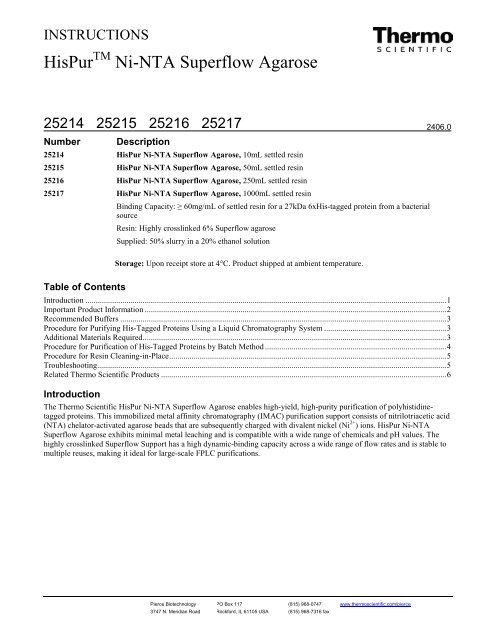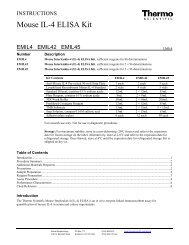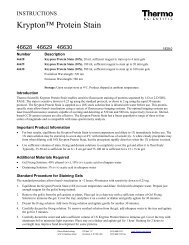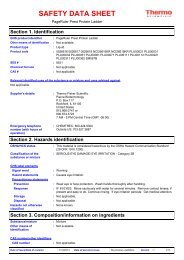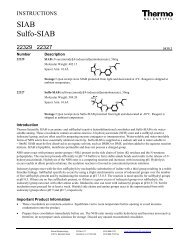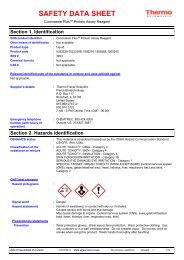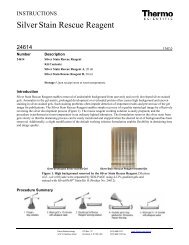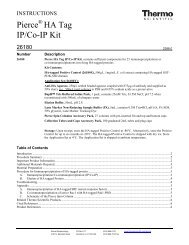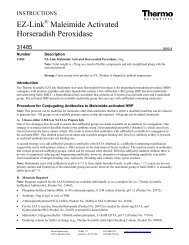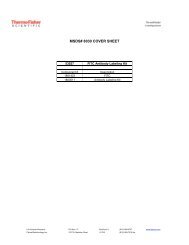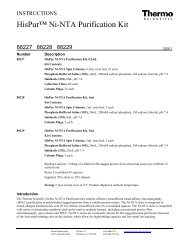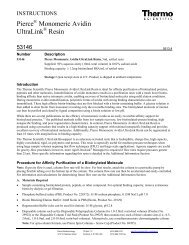HisPur Ni-NTA Superflow Agarose - Pierce
HisPur Ni-NTA Superflow Agarose - Pierce
HisPur Ni-NTA Superflow Agarose - Pierce
Create successful ePaper yourself
Turn your PDF publications into a flip-book with our unique Google optimized e-Paper software.
INSTRUCTIONS<br />
<strong>HisPur</strong> TM <strong>Ni</strong>-<strong>NTA</strong> <strong>Superflow</strong> <strong>Agarose</strong><br />
25214 25215 25216 25217<br />
Number<br />
Description<br />
25214 <strong>HisPur</strong> <strong>Ni</strong>-<strong>NTA</strong> <strong>Superflow</strong> <strong>Agarose</strong>, 10mL settled resin<br />
25215 <strong>HisPur</strong> <strong>Ni</strong>-<strong>NTA</strong> <strong>Superflow</strong> <strong>Agarose</strong>, 50mL settled resin<br />
25216 <strong>HisPur</strong> <strong>Ni</strong>-<strong>NTA</strong> <strong>Superflow</strong> <strong>Agarose</strong>, 250mL settled resin<br />
25217 <strong>HisPur</strong> <strong>Ni</strong>-<strong>NTA</strong> <strong>Superflow</strong> <strong>Agarose</strong>, 1000mL settled resin<br />
Binding Capacity: ≥ 60mg/mL of settled resin for a 27kDa 6xHis-tagged protein from a bacterial<br />
source<br />
Resin: Highly crosslinked 6% <strong>Superflow</strong> agarose<br />
Supplied: 50% slurry in a 20% ethanol solution<br />
2406.0<br />
Storage: Upon receipt store at 4°C. Product shipped at ambient temperature.<br />
Table of Contents<br />
Introduction ................................................................................................................................................................................. 1<br />
Important Product Information .................................................................................................................................................... 2<br />
Recommended Buffers ................................................................................................................................................................ 3<br />
Procedure for Purifying His-Tagged Proteins Using a Liquid Chromatography System ............................................................ 3<br />
Additional Materials Required ..................................................................................................................................................... 3<br />
Procedure for Purification of His-Tagged Proteins by Batch Method ......................................................................................... 4<br />
Procedure for Resin Cleaning-in-Place ........................................................................................................................................ 5<br />
Troubleshooting ........................................................................................................................................................................... 5<br />
Related Thermo Scientific Products ............................................................................................................................................ 6<br />
Introduction<br />
The Thermo Scientific <strong>HisPur</strong> <strong>Ni</strong>-<strong>NTA</strong> <strong>Superflow</strong> <strong>Agarose</strong> enables high-yield, high-purity purification of polyhistidinetagged<br />
proteins. This immobilized metal affinity chromatography (IMAC) purification support consists of nitrilotriacetic acid<br />
(<strong>NTA</strong>) chelator-activated agarose beads that are subsequently charged with divalent nickel (<strong>Ni</strong> 2+ ) ions. <strong>HisPur</strong> <strong>Ni</strong>-<strong>NTA</strong><br />
<strong>Superflow</strong> <strong>Agarose</strong> exhibits minimal metal leaching and is compatible with a wide range of chemicals and pH values. The<br />
highly crosslinked <strong>Superflow</strong> Support has a high dynamic-binding capacity across a wide range of flow rates and is stable to<br />
multiple reuses, making it ideal for large-scale FPLC purifications.<br />
<strong>Pierce</strong> Biotechnology PO Box 117 (815) 968-0747 www.thermoscientific.com/pierce<br />
3747 N. Meridian Road Rockford, IL 61105 USA (815) 968-7316 fax
Table 1. Properties of Thermo Scientific <strong>HisPur</strong> <strong>Ni</strong>-<strong>NTA</strong> <strong>Superflow</strong> <strong>Agarose</strong>.<br />
Support : <strong>Superflow</strong> 6 Resin, 6% highly crosslinked agarose<br />
Bead Size : 60-160µm<br />
Recommended Linear Flow Rate: < 150cm/hr (binding, wash, elution)<br />
Maximum Linear Flow Rate † : 1200cm/hr<br />
Metal Loading Capacity: > 15µM <strong>Ni</strong> 2+ /mL resin<br />
Typical Static Capacity: ~60mg 6xHis-GFP/mL resin<br />
Typical Dynamic Capacity * : ~20mg 6xHis-GFP/mL resin<br />
Chemical Compatibility: 1M acetic acid, pH 2; 0.1M HCl, pH 1; 1% SDS, pH 7;<br />
6M guanidine•HCl; 70% ethanol: ≥ 1 week at 37°C<br />
8M urea, 10mM DTT, 5mM TCEP: ≥ 2hr at 22°C<br />
pH Limits: pH 3-9 (≥ 1 week at 4°C)<br />
pH 2-3 or 9-12 (≥ 2 hours at 22°C)<br />
Storage Solution: 20% ethanol<br />
Reuse: Up to 25 times<br />
† Maximum linear flow-rate conditions:<br />
Column dimensions (w × h): 13mm × 38mm (5mL resin)<br />
Ultrapure water at room temperature<br />
Linear flow rate = volumetric flow rate (mL/min) × 60 (min/hr)/cross sectional area (cm 2 )<br />
* Dynamic binding conditions (10% breakthrough):<br />
Sample: 1mg/mL 6xHis-GFP (27kDa) pure protein in 20mM NaH 2PO 4, 300mM NaCl, 10mM imidazole<br />
Column dimensions (w × h): 5mm × 50mm (1mL resin)<br />
Flow rate: 1mL/min<br />
Important Product Information<br />
• Protein yield and purity are dependent upon the expression level, conformation and solubility characteristics of the<br />
recombinant fusion protein as well as the buffer conditions and flow rates used. Therefore, it is important to optimize<br />
these parameters before attempting a large-scale purification. For best results, perform a small-scale test to estimate the<br />
expression level and determine the solubility of each His-tagged protein. Decreasing the flow rate during the sample load<br />
will increase binding capacity. For some proteins, adjustments to the imidazole concentration may be required to<br />
decrease nonspecific binding and increase yield.<br />
• To avoid sample loss, try to not exceed the maximum resin binding capacity for the target protein for the purification<br />
conditions used. Volumes will vary based on the protein and expression efficiency and will have to be determined and<br />
optimized for each over-expressed protein. Typically, over-expressed proteins represent 1-30% of the final sample<br />
protein concentration. Adjust resin or sample volume as appropriate.<br />
• Optimization of cell lysis procedures is critical for maximizing protein yield. Some methods for protein extraction<br />
include using commercially available detergent-based reagents, such as Thermo Scientific B-PER Bacterial Protein<br />
Extraction Reagent with Enzymes (Product No. 90078), and mechanical methods, such as freeze/thaw cycles, sonication<br />
or French press. Confirm cell disruption before proceeding to protein purification. Add EDTA-free protease inhibitors,<br />
such as Thermo Scientific Halt Protease and Phosphatase Inhibitor Cocktail, EDTA-free (Product No. 78437), during<br />
lysis procedures to protect proteins from degradation.<br />
• Over-expressed proteins can often be sequestered in inclusion bodies. The <strong>Ni</strong>-<strong>NTA</strong> <strong>Superflow</strong> Resin is compatible with<br />
purification under native or denaturing conditions. Inclusion bodies containing His-tagged proteins can be solubilized in<br />
8M urea, 6M guanidine or Thermo Scientific Inclusion Body Solubilization Reagent (Product No. 78115) and purified<br />
with the <strong>Ni</strong>-<strong>NTA</strong> <strong>Superflow</strong> Resin, but a denaturant must be added to buffers so the protein remains soluble throughout<br />
the procedure.<br />
• For liquid chromatography applications, use highly pure buffer components and ultrapure water. Use low-absorbance<br />
imidazole (Fisher Scientific, Product No. BP 305-50) to avoid UV interference. Degas or filter buffers through a 0.45μm<br />
filter before use.<br />
• Avoid using chelators, such as EDTA, which will disrupt resin function and potentially strip the nickel from the resin.<br />
• Reducing agents, such as 10mM DTT and 5mM TCEP, have been tested and do not affect function of the resin. Avoid<br />
using higher concentrations of these reducing agents.<br />
<strong>Pierce</strong> Biotechnology PO Box 117 (815) 968-0747 www.thermoscientific.com/pierce<br />
3747 N. Meridian Road Rockford, IL 61105 USA (815) 968-7316 fax<br />
2
Recommended Buffers<br />
For native conditions:<br />
• Equilibration Buffer: 20mM sodium phosphate, 300mM sodium chloride, 10mM imidazole; pH 7.4<br />
• Wash Buffer: 20mM sodium phosphate, 300mM sodium chloride, 20-30mM imidazole; pH 7.4<br />
• Elution Buffer: 20mM sodium phosphate, 300mM sodium chloride, 300mM imidazole; pH 7.4<br />
For denaturing conditions:<br />
• Equilibration Buffer: 20mM sodium phosphate, 300mM sodium chloride, 6M guanidine•HCl, 10mM imidazole; pH 7.4<br />
• Wash Buffer: 20mM sodium phosphate, 300mM sodium chloride, 6M guanidine•HCl, 20-30mM imidazole; pH 7.4<br />
• Elution Buffer: 20mM sodium phosphate, 300mM sodium chloride, 6M guanidine•HCl, 300mM imidazole; pH 7.4<br />
For regeneration:<br />
• Regeneration Buffer: MES Buffer: 20mM 2-(N-morpholine)-ethanesulfonic acid, 0.1M sodium chloride; pH 5.0<br />
• Ultrapure water<br />
• 20% ethanol in ultrapure water<br />
For clean-in-place:<br />
• 6M guanidine•HCl with 1% non-ionic detergent<br />
• Ultrapure water<br />
Procedure for Purifying His-Tagged Proteins Using a Liquid Chromatography System<br />
Note: Monitor and collect all fractions during a purification to avoid accidental loss of target protein. User can adjust sample<br />
collection based on their needs and comfort level with the purification methods used. Maximum flow rates will be dependent<br />
on application and equipment used. The procedure may be performed at room temperature or 4°C.<br />
A. Additional Materials Required<br />
• Suitable liquid chromatography (LC) system<br />
• Empty column for resin packing (follow column manufacturer’s protocol for packing)<br />
• Recommended buffers (see above) and volumes (see below)<br />
B. Procedure<br />
1. Pack an appropriate-sized column with resin according to column manufacturer’s protocol. Ensure the packing flow rate<br />
is at least 20% faster than the flow rate that will be used during purification.<br />
2. Equilibrate the column and all buffers to working temperature. Purifications can be performed at room temperature or<br />
4°C. Ensure all solutions are degassed.<br />
3. Prepare the LC system by washing pumps and filling tubing with buffer. To avoid introducing air into the system, allow<br />
a few drops of buffer to flow from the tubing into the column top. Connect column to the tubing.<br />
4. Equilibrate the column with 5-10 column volumes of the Equilibration Buffer at a flow rate of 300cm/hr or less<br />
(150cm/hr recommended).<br />
<strong>Pierce</strong> Biotechnology PO Box 117 (815) 968-0747 www.thermoscientific.com/pierce<br />
3747 N. Meridian Road Rockford, IL 61105 USA (815) 968-7316 fax<br />
3
5. Apply any sample volume that does not exceed the column binding capacity for target protein at a flow rate of 300cm/hr<br />
or less (150cm/hr recommended).<br />
Note: Binding capacity is flow rate- and protein-dependent. Decreasing the flow rate during the sample load will<br />
increase binding capacity. Higher flow rates will decrease production time, but may result in losing a small portion of the<br />
target protein in the flow-through fraction.<br />
Note: For maximum binding, prepare sample by mixing protein extract 1:1 with Equilibration Buffer (to adjust the<br />
sample to the ionic strength and pH of the Equilibration Buffer) before applying to the column.<br />
Note: If the sample contains insoluble matter, centrifuge or filter (0.45µm filter) before use.<br />
6. Wash the resin at a flow rate of 300cm/hr or less (150cm/hr recommended) with 10-15 column volumes of Wash Buffer<br />
or until the absorbance approaches baseline.<br />
7. Elute at a flow rate of 300cm/hr or less (150cm/hr recommended) with approximately 5-10 column volumes of Elution<br />
Buffer and collect fractions.<br />
Note: Monitor protein elution by measuring the absorbance of the fractions at 280nm. The eluted protein can be directly<br />
analyzed by SDS-PAGE. To remove excess imidazole for downstream applications, use gel filtration or dialysis (e.g.,<br />
Thermo Scientific Zeba Spin Desalting Columns or Slide-A-Lyzer Dialysis Cassettes (see the Related Thermo Scientific<br />
Products Section).<br />
8. Regenerate column by washing with 10 column volumes of Regeneration Buffer, followed by 10 column volumes of<br />
ultrapure water at a flow rate of 300cm/hr or less (150cm/hr recommended). The column is now ready for reuse (proceed<br />
to step 1), storage (proceed to step 9) or routine clean-in-place procedures (see Procedure for Resin Cleaning-in-Place<br />
Section).<br />
9. For storage, equilibrate the column with 5 column volumes of 20% ethanol. Seal column and store at 4°C.<br />
Procedure for Purification of His-Tagged Proteins by Batch Method<br />
Note: The procedure may be performed at room temperature or 4°C. The <strong>Ni</strong>-<strong>NTA</strong> <strong>Superflow</strong> Resin allows for customization<br />
of your purification strategy. Purification conditions can be scaled as needed in several formats. A batch method based on<br />
centrifugation is included below. Alternatively, methods based on vacuum filtration or gravity flow can be used to collect<br />
flow-through, wash and elution fractions.<br />
A. Additional Materials Required<br />
• Suitable vessel or sample-handling containers, such as centrifugation bottle or spin filters/columns<br />
• Recommended buffers (see Recommended Buffers Section) and volumes (see below)<br />
• End-over-end rotary mixer or equivalent mixing apparatus<br />
B. Procedure<br />
1. Add the required amount of <strong>Ni</strong>-<strong>NTA</strong> <strong>Superflow</strong> Resin to a container with 3-4 times the volume of the resin quantity<br />
used. Centrifuge for 2 minutes at 700 × g and carefully remove and discard the supernatant.<br />
2. Add two resin-bed volumes of Equilibration Buffer and mix until the resin is fully suspended.<br />
3. Centrifuge for 2 minutes at 700 × g and carefully remove and discard buffer.<br />
4. Prepare sample by mixing the protein extract with Equilibration Buffer to a volume greater than or equal to the resin bed<br />
volume.<br />
5. Add the prepared protein extract to the tube and mix slowly for 30 minutes ensuring the resin stays suspended. For best<br />
results, use an end-over-end rotary mixer.<br />
6. Centrifuge for 2 minutes at 700 × g and carefully remove supernatant. If desired, save supernatant for downstream<br />
analysis.<br />
7. Wash the resin with two resin-bed volumes of Wash Buffer. Centrifuge for 2 minutes at 700 × g and carefully remove<br />
supernatant. If desired, save supernatant for downstream analysis.<br />
<strong>Pierce</strong> Biotechnology PO Box 117 (815) 968-0747 www.thermoscientific.com/pierce<br />
3747 N. Meridian Road Rockford, IL 61105 USA (815) 968-7316 fax<br />
4
8. Repeat wash step three times.<br />
9. Elute bound His-tagged proteins by resuspending resin bed in one resin-bed volume of Elution Buffer. Mix slowly for<br />
10 minutes making sure resin stays suspended.<br />
10. Spin tube for 2 minutes at 700 × g. Carefully remove and save the supernatant.<br />
11. Repeat elution steps 9-10 two to four times, saving each supernatant fraction in a separate tube.<br />
12. Monitor protein elution by measuring the absorbance of the fractions at 280nm or by Thermo Scientific Coomassie Plus<br />
(Bradford) Assay Reagent (Product No. 23238) or <strong>Pierce</strong> 660nm Protein Assay (Product No. 22660). To avoid<br />
interference with the assay, dilute the samples at least 1:2 to decrease the imidazole concentration before performing the<br />
protein assay. The eluted protein can be directly analyzed by SDS-PAGE. To remove excess imidazole for other<br />
downstream applications, use gel filtration or dialysis (e.g., Zeba Spin Desalting Columns or Slide-A-Lyzer Dialysis<br />
Cassettes (see the Related Thermo Scientific Products Section).<br />
13. Regenerate the resin by resuspending the resin with 10 resin-bed volumes of Regeneration Buffer. Centrifuge tube for<br />
2 minutes at 700 × g. Discard supernatant. Repeat once.<br />
14. Resuspend resin with 10 resin-bed volumes of ultrapure water. Centrifuge tube for 2 minutes at 700 × g. Discard<br />
supernatant. Repeat once. The column is now ready for reuse (proceed to step 1), storage (proceed to step 15) or routine<br />
clean-in-place procedures (see Procedure for Resin Cleaning-in-Place Section).<br />
15. For storage, resuspend resin with 1 column volume of 20% ethanol. Seal column and store at 4 o C.<br />
Procedure for Resin Cleaning-in-Place<br />
The <strong>Ni</strong>-<strong>NTA</strong> <strong>Superflow</strong> Resin can be used multiple times without affecting protein yield or purity. To prevent cross<br />
contamination of samples, designate a given column to one specific fusion protein. If an increase in backpressure or decrease<br />
in performance is observed, the following cleaning procedures can be followed.<br />
1. To remove precipitated or denatured proteins and hydrophobic substances, wash resin with 2 volumes of<br />
6M guanidine•HCl plus 1% nonionic detergent (e.g., ThermoScientific Triton X-100 Surfact Amps Detergent Solution)<br />
with 10 minutes of contact time followed by 5 volumes of ultrapure water at a flow rate of less than 300cm/hr (150cm/hr<br />
recommended).<br />
2. Store resin in 20% ethanol at 4°C.<br />
Troubleshooting<br />
Problem Possible Cause Solution<br />
Low protein yield Poor expression of soluble protein Optimize expression conditions (e.g., lower temperature during<br />
induction, vary induction time, optimize codon usage for<br />
expression system)<br />
Continued on next page<br />
His-tagged protein formed<br />
inclusion bodies<br />
Insufficient cell lysis and<br />
extraction<br />
Fusion protein did not bind to the<br />
column<br />
Flow rate was too fast<br />
Column washing was too<br />
extensive<br />
Alter growth conditions to minimize inclusion body formation<br />
and maximize soluble protein yield; alternatively, solubilize<br />
inclusion bodies and perform the purification with a compatible<br />
denaturant (e.g., Thermo Scientific Inclusion Body<br />
Solubilization Reagent, Product No. 78115)<br />
Optimize cell lysis protocol<br />
Verify the sequence<br />
Perform an ELISA or Western blot using an antibody against<br />
the His tag to make sure the His tag is present<br />
Decrease flow rate during binding to allow for greater residence<br />
time and increased binding of fusion protein<br />
Reduce imidizole concentration in Wash Buffer<br />
Reduce amount of Wash Buffer used<br />
<strong>Pierce</strong> Biotechnology PO Box 117 (815) 968-0747 www.thermoscientific.com/pierce<br />
3747 N. Meridian Road Rockford, IL 61105 USA (815) 968-7316 fax<br />
5
Continued from previous page<br />
Poor protein<br />
purity<br />
Insufficient washing<br />
Increase duration of wash<br />
Modify imidazole concentration and pH of the Equilibration or<br />
Wash Buffer<br />
Column was dirty<br />
Follow clean-in-place procedure to remove nonspecifically<br />
bound proteins<br />
Slow column flow Column was overloaded Apply less protein extract onto the column<br />
Extract was too viscous or highly<br />
particulate<br />
Dilute lysate with Equilibration Buffer to decrease viscosity<br />
Centrifuge lysate at higher speed to remove particulate<br />
Related Thermo Scientific Products<br />
25228-31 <strong>HisPur</strong> Cobalt <strong>Superflow</strong> <strong>Agarose</strong><br />
25236-9 <strong>Pierce</strong> Glutathione <strong>Superflow</strong> <strong>Agarose</strong><br />
89896-8 <strong>Pierce</strong> Centrifuge Columns<br />
87785 Halt Protease Inhibitor Cocktail (100X), EDTA-free, 1mL<br />
88666 <strong>Pierce</strong> Protease Inhibitor Tablets, EDTA-free, 30 tablets<br />
88270 <strong>Pierce</strong> High Capacity Endotoxin Removal Resin, 10mL<br />
88282 <strong>Pierce</strong> LAL Chromogenic Endotoxin Quantitation Kit<br />
90078 B-PER Bacterial Protein Extraction Reagent with Enzymes, 250mL<br />
23238 Coomassie Plus (Bradford) Assay Reagent, 300mL<br />
22660 <strong>Pierce</strong> 660nm Protein Assay Reagent, 750mL<br />
78115 Inclusion Body Solubilization Reagent, 100mL<br />
24115 8M Guanidine•HCl Solution, 200mL<br />
89891-4 Zeba Spin Desalting Columns, 7K MWCO<br />
87730-8 Slide-A-Lyzer G2 Dialysis Cassettes, 10K MWCO<br />
28313-4 Triton X-100 Surfact Amps Detergent Solution<br />
Triton is a trademark of the Dow Chemical Company.<br />
This product (“Product”) is warranted to operate or perform substantially in conformance with published Product specifications in effect at the time of sale,<br />
as set forth in the Product documentation, specifications and/or accompanying package inserts (“Documentation”) and to be free from defects in material and<br />
workmanship. Unless otherwise expressly authorized in writing, Products are supplied for research use only. No claim of suitability for use in applications<br />
regulated by FDA is made. The warranty provided herein is valid only when used by properly trained individuals. Unless otherwise stated in the<br />
Documentation, this warranty is limited to one year from date of shipment when the Product is subjected to normal, proper and intended usage. This<br />
warranty does not extend to anyone other than the original purchaser of the Product (“Buyer”).<br />
No other warranties, express or implied, are granted, including without limitation, implied warranties of merchantability, fitness for any particular<br />
purpose, or non infringement. Buyer’s exclusive remedy for non-conforming Products during the warranty period is limited to replacement of or<br />
refund for the non-conforming Product(s).<br />
There is no obligation to replace Products as the result of (i) accident, disaster or event of force majeure, (ii) misuse, fault or negligence of or by Buyer, (iii)<br />
use of the Products in a manner for which they were not designed, or (iv) improper storage and handling of the Products.<br />
Current product instructions are available at www.thermoscientific.com/pierce. For a faxed copy, call 800-874-3723 or contact your local distributor.<br />
© 2012 Thermo Fisher Scientific Inc. All rights reserved. Unless otherwise indicated, all trademarks are property of Thermo Fisher Scientific Inc. and its<br />
subsidiaries. Printed in the USA.<br />
<strong>Pierce</strong> Biotechnology PO Box 117 (815) 968-0747 www.thermoscientific.com/pierce<br />
3747 N. Meridian Road Rockford, IL 61105 USA (815) 968-7316 fax<br />
6


